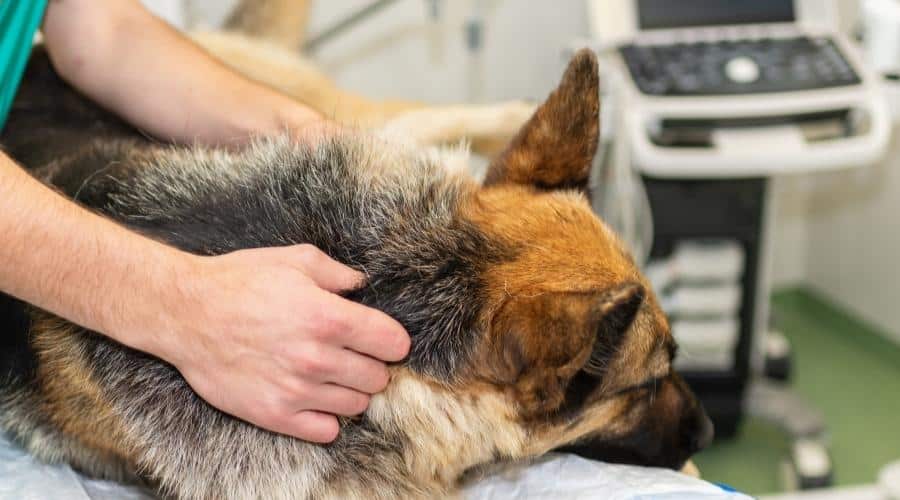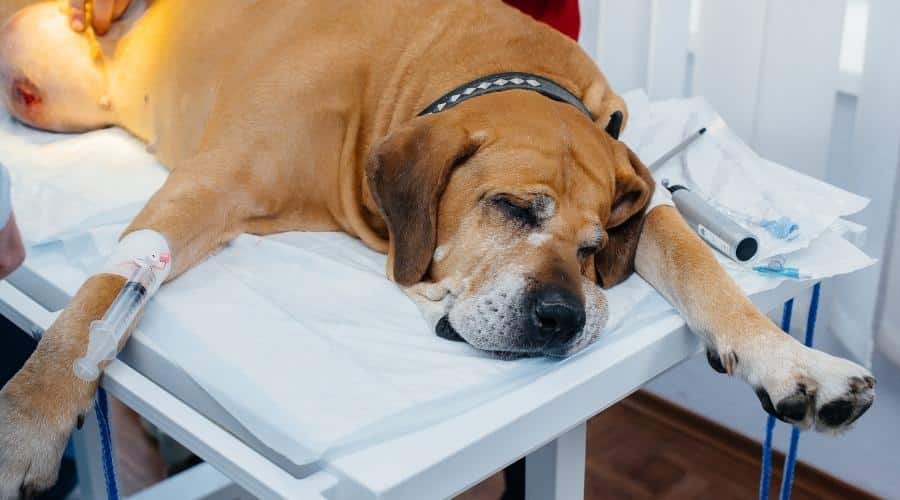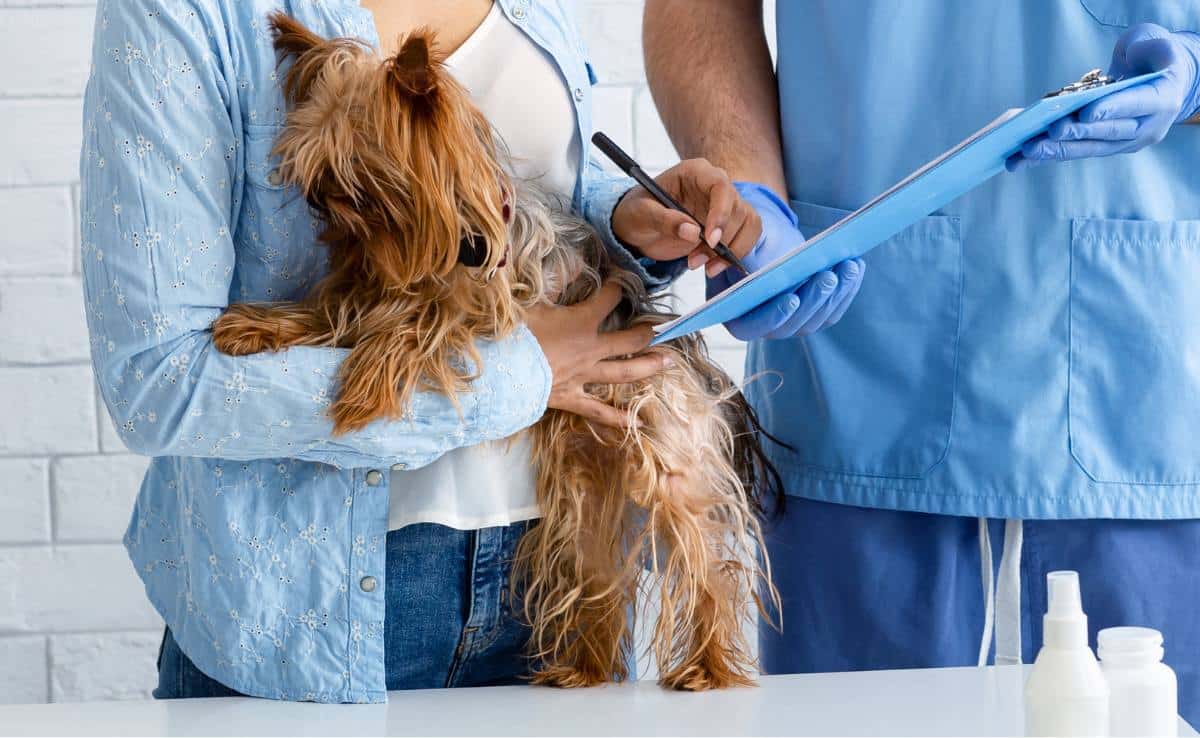Best Pet Insurance For Large Breed Dogs
When you purchase through links on our site, we may earn a commission. Here’s how it works.
If you are the proud owner of a large dog, you might already know that these gorgeous giants usually cost more than smaller ones. Not only do they need everything in XXL sizes, including crates and beds, but they need much more food too. And the higher costs do not stop there – they also typically cost more to insure. The typically higher price makes it essential to seek value for your hard-earned dollars.
It’s also important to pick the right insurance coverage for your dog because not all insurance policies are created equal, nor do they cover the same conditions. Sure, not all big dogs suffer from the same health concerns, but many issues are more common in larger dogs than in smaller ones. So, it’s crucial to pick an insurance policy that covers most of what your big pooch might suffer.
So, whether you have a Great Dane, a Labrador Retriever, or a Bernese Mountain Dog, we have handpicked the best pet insurance for large breed dogs. We have reviewed each policy to help you make the best decision for your large doggo. Plus, we take you through what you should consider making the right choice, including common big breed health conditions and all the insurance terminology you need to know.
At A Glance
Table of Contents
Is Pet Insurance Worth It?
This is one of the first questions that spring to dog parents’ minds. Is pet insurance worth it, or is it just another unnecessary expenditure to add to the doggy list? We take you through the costs of some common health problems among sizeable breeds later, but it is important to note that some conditions cost more than $10,000 to treat! Two-thirds of pet owners surveyed by Liberty Mutual Insurance said they could not afford unexpected medical bills without putting themselves under financial strain.
So, for most dog owners, the answer is yes; pet insurance is worth it. The right pet insurance can protect you and your family from unexpected financial troubles. In addition to peace of mind, it also ensures that your big buddy’s health is covered should the worst happen. But it’s still important to pick the proper insurance. So, let’s find out more about that.
Common Large Dog Health Issues

It is essential to research the specific conditions your dog might be predisposed to. So be sure to check out your dog’s national breed clubs, which usually detail the breed-specific health concerns or a recognized website such as the American Kennel Club.
Here are the most common health issues in large canines.
Hip & Elbow Dysplasia
Hip and elbow dysplasia are among the most common health issues in large breed dogs, especially hip dysplasia. According to the American College of Veterinary Surgeons (ACVS), genetics plays the most significant factor in hip and elbow dysplasia. Since joint dysplasia is more common in bigger dogs, working with a breeder who provides the parent’s good hip scores is recommended.
Nonetheless, your pup could still develop these conditions, which can be costly to treat. Over time, joint dysplasia causes mobility issues, pain, muscle wastage, and arthritis. In many cases, surgery is required to improve your dog’s quality of life. Corrective surgery costs between $3,500 and $7,000 per hip on average and less for elbows. And if your dog requires surgery on more than one joint, you are faced with a huge bill.
Eye Conditions
Like most dog breeds, bigger dogs are predisposed to several eye conditions. Common eye issues include ectropion, entropion, cherry eye, cataracts, and progressive retinal atrophy (PRA). Thankfully, you can manage many eye concerns with better hygiene and medication such as eye drops. However, surgery is sometimes needed to improve your dog’s quality of life or prevent total vision loss.
The average cost of a one-off eye exam accompanied by a course of antibiotic drops is approximately $100, maybe more regarding large dog breeds. For lower prices like this, it’s not always in your best interest to claim as it is likely to increase your premiums. But if your pup requires surgery, for example, to correct the cherry eye, the average price falls anywhere between $1,100 and $2,000. The cost depends on the breed, severity, and number of affected eyelids.
Cardiac Concerns
Many large dog breeds are predisposed to heart problems and heart failure. The most common cause of heart failure in big dog breeds is dilated cardiomyopathy (DCM). Essentially, the heart’s walls become thinner due to degeneration, weakening the heart muscle. It can be progressive or sudden and can sometimes be managed with daily medication.
However, your dog may require surgery to prevent heart failure in some advanced cases. Or, if your pup suffers from cardiac arrest, you might be faced with emergency life-saving surgery. Surgery to resolve DCM can cost anywhere between $10,000 and $20,000 depending on the dog breed, severity of the disease, and complications making this one of the most costly health issues that face bigger breed dogs.
Bloat
Also known as gastric dilation-volvulus (GDV), larger dogs are more at risk of this life-threatening health issue than small dogs. Especially dogs with a deep chest. Little is known about what causes GDV, but some recognized risk factors exist beyond being large. These include a family history of bloat, feeding once a day, eating quickly, and eating close to exercise.
Unlike other conditions on this list, this issue develops suddenly without much warning. This is why bloat is often called the “mother of emergencies.” It can result in death in as little as 30 minutes and requires urgent surgery to save the dog’s life. Depending on the breed, the severity, and the complications, this life-saving emergency surgery can cost anywhere between $1,500 and $7,500.
Hypothyroidism
Hypothyroidism is caused by reduced production and release of hormones from the thyroid gland. Symptoms include mental dullness, lethargy, weight gain, hair loss, and repeated skin infections. Vets use tests to diagnose it, including bloodwork and regular monitoring of hormone levels. Thankfully, hypothyroidism is manageable with daily medication.
However, the long-term costs and the diagnostic work beforehand can build up. Some insurance policies cover diagnostic work and prescriptions, but not all. The average price of managing hypothyroidism yearly ranges from $300 to $700, with an additional $50 to $150 for initial diagnostic work. Your pup is likely to command a higher average price thanks to its larger body mass.
Considerations In Choosing an Insurer

Having a choice is excellent for tailoring your dog’s policy to ensure the best coverage for them. But it can also make things tricky. Let’s think through all the considerations you need to assess when choosing the best insurance for your large breed dog.
Enrollment Rules & Waiting Periods
The majority of companies have enrollment rules about what age they will accept your dog and when they can begin new coverage. Some only offer coverage starting at eight-week-old puppies, while some don’t allow new signups for ages 14 years or older. So be sure to check out the enrollment rules.
Most insurance companies also have something called a “waiting period.” The waiting period is the time you have to wait between signup and when your dog is covered, and every company has different waiting periods. Implementing a waiting period prevents owners from taking out policies only when needed. For accidents, the typical waiting period is several days. And for illnesses, it is usually longer, ranging from days to months depending on the condition and the provider.
Types Of Coverage & Premiums
There are two main types of coverage to choose from:
- Accident-only – This type of coverage covers accidents only. Accidents could include being hit by a vehicle, poisoning, or the ingestion of foreign objects, to name just a few examples.
- Accident and Illness – This type of coverage includes most accidents and illnesses, except for pre-existing conditions and before the end of waiting periods. Accident and illness coverage is the most popular option as it protects pet owners from the majority of unexpected medical expenses.
Some companies also offer a wellness plan (aka preventative care plan) during the enrollment process. This commonly covers routine vet expenses (i.e., annual exams, spay/neuter procedures, vaccinations, etc.) but varies by provider. It’s typically available as an add-on to an accident-only or accident and illness policy, but some companies allow you to purchase it without an insurance policy. This add-on coverage isn’t technically an insurance product.
To pick the best option for you and your bigger dog, you need to consider what type of plan you need alongside your budget. Many companies offer all three coverage options, although not all provide an additional wellness plan. Some companies also offer different levels of coverage within each coverage category, for example, gold, silver, and bronze. So be sure to read through all of your options and the fine print before you sign.
Premiums are the fee you pay for your pet to be covered, and premiums are usually paid monthly or annually, depending on your contract.
According to NAPHIA (North American Pet Health Insurance Association), the average monthly premium for an accident and illness dog insurance policy in the U.S. is $62.44 ($32.10 for cats).
Most families find this monthly expense much more manageable than an unexpected bill.
Deductibles & Claim Payouts
Deductibles refer to the amount you have to pay before the insurance company begins coverage. The insurance company will not reimburse you for any claim until you have met the deductible. The deductible is generally annual or per incident, depending on your contract. Usually, increasing your deductible amount (how much you owe before coverage begins) can help lower your premium. But this may not always be the case.
Claim payouts are one of the most important factors to consider when picking a policy. There are several ways that an insurer caps the amount they reimburse you. There could be a claim payout limit per incident, per calendar year, or across the lifespan of your dog. Once the limit has been reached, you are responsible for covering any additional medical costs. If you choose a lifetime claim payout, your premiums will likely be higher, but this can be the best option for some families to manage large health concerns that hopefully only happen once in a lifetime.
Exclusions
The exclusions in a policy are the list of scenarios and conditions that are not included in your coverage. This is another vital aspect of your insurance policy to be aware of. For example, suppose a policy excludes hip dysplasia or emergency bloat surgeries. In that case, it might not be the best choice for your larger dog. You can find exclusions outlined in the policy documents. Make sure you understand what is included and excluded before signing the contract.
Who Offers The Optimal Fit For Your Large Breed Dog?
Below we have listed our top insurance picks that offer excellent pet insurance for you and your large pooch to ponder. And, once you are ready, we’ve made a free quote form that provides customized policy quotes from top pet insurance companies when you fill in your pet’s details. By entering your pet’s specific characteristics, you can get a better understanding of the coverage needed.
Best Overall Pet Insurance
After considering the common health concerns that affect many large dogs and what insurance coverage they are likely to need, we have chosen this winner. Our top pick is Embrace because they cover hereditary conditions such as hip dysplasia and hypothyroidism, common concerns for large dogs. They also offer a fair evaluation of some pre-existing conditions if it meets their criteria.
Embrace also covers the cost of emergency surgery, including GDV and ongoing medication needed as long as this detail is outlined in your policy. They also have a diminishing deductible, which is an excellent bonus for those customers who do not make claims for multiple years. Overall, we believe Embrace is a top choice for most big dogs.
Best For Older Dogs
Best For Bilateral Conditions (Including Hip & Elbow Dysplasia)
Other Options
Ways To Save Money
Some large dog owners can save money on insurance coverage depending on their requirements and situation. Here are some of the ways you might save a little bit of money:
Increase The Deductible
You can sometimes reduce your premium by increasing the deductible, the amount of money you are responsible for before the insurance company starts coverage. However, if you choose to do this, be sure that you can pay the higher initial amount before making a claim.
Pay Annually
Most insurance companies usually offer two ways of paying premiums, either monthly or annually. Some companies charge a “transaction fee” if you opt for monthly payments. So, you can sometimes save money if you opt for the annual one-time premium. But again, only do this if it suits your financial situation.
Multi-Pet Discount
Some insurance companies offer a multi-pet discount if you take out more than one policy for multiple pets. It’s essential to tailor individual coverage to each pet to meet their particular needs. Some insurance companies offer up to a 10% multi-pet discount if you meet their criteria. Some companies only offer multi-pet discounts on additional pets (not the first), so be sure to clarify this point before enrolling in a new policy.
Final Thoughts
As you now know, investing in an insurance policy for your big dog is worth it for most families. It offers you peace of mind knowing that your gentle giant is taken care of should the worst happen, and you are supported financially without risking economic trouble when faced with a potentially huge and unexpected medical bill.
Not all large breed dogs are the same, nor are they predisposed to all the same health issues. But there are many size-specific health concerns that you need to be aware of and ensure that they are covered. Always research your dog’s specific breed and genetic details to note what they are most likely to suffer from, and always read the fine print before signing on the dotted line. If there is something that you are not sure about, it’s wise to call the company to walk through the policy. You could also ask your vet. If they are well informed on pet insurance, they should be happy to talk you through the best options for you and your large doggo.



